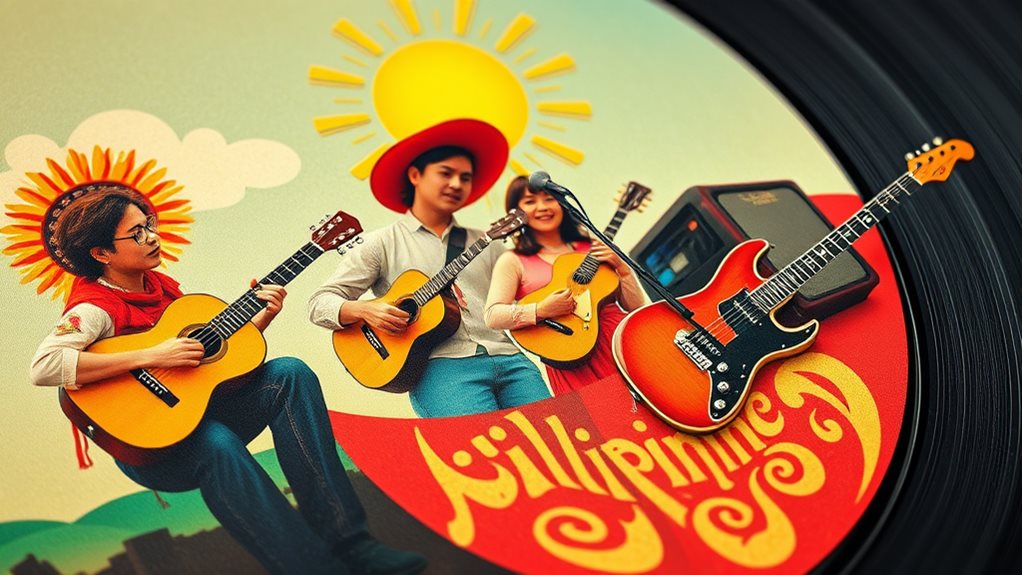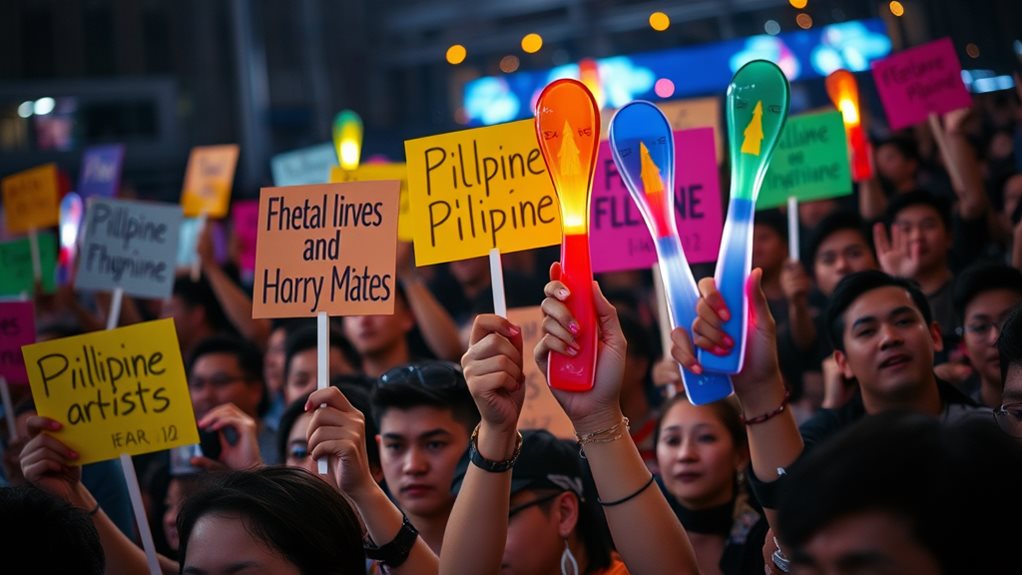P-pop's global influence stems from its unique blend of traditional Filipino music and Western pop styles. This fusion is evident in the music of groups like SB19 and Bini, which have achieved success on international platforms such as Billboard and Spotify. Their songs often incorporate Tagalog lyrics, showcasing Filipino identity and resonating with a global fanbase. This fanbase is passionate and actively promotes P-pop, further expanding its reach and influence. The genre's future looks promising, with continued growth and exciting collaborations on the horizon.
A Unique Musical Blend

P-pop's unique sound is a deliberate blend of diverse musical styles****. This fusion of sounds isn't accidental, but rather a thoughtful crafting of a sound that's both familiar and uniquely Filipino.
Western pop, K-pop, and J-pop influences are skillfully blended, resulting in a vibrant tapestry of sounds. Upbeat tempos and catchy hooks are instantly recognizable elements borrowed and adapted from these genres.
Lyrics in P-pop reflect the country's linguistic diversity**. Tagalog lyrics create a strong connection to Filipino audiences, while Taglish, a mix of Tagalog and English, reflects the country's linguistic reality**. Regional dialects sometimes appear, adding another layer of authenticity and cultural depth. This thoughtful integration resonates with a broad spectrum of listeners.
P-pop's genre fusion extends beyond lyrics to its rhythm and instrumentation. Influences from various sources are creatively interwoven to produce something refreshingly new.
This conscious blending of sounds speaks volumes about P-pop's evolution and its position on the global stage****. It's not merely a matter of imitation; it's a masterful act of creation, demonstrating the power of genre fusion to create something truly unique.
Global P-Pop Recognition
Filipino pop music, or P-pop, has achieved significant global recognition****. This is evident in its ability to transcend national borders, fueled by streaming platforms and a passionate global fanbase.
SB19 and Bini are leading ambassadors of this genre, captivating audiences worldwide with their unique blend of Filipino and international sounds.
International recognition is tangible, with Sarah Geronimo's Billboard Women in Music Award solidifying P-pop's growing influence.
Collaborations with international artists have opened doors for Filipino artists to showcase their talent on a global stage. The success of groups like Bini, with millions of views on their music videos, demonstrates the genre's appeal.
P-pop can compete with and even surpass established international artists on popular streaming platforms, further cementing its global presence.
P-pop's increasing popularity has boosted the overall visibility of the Filipino music industry, attracting international attention. The fusion of traditional Filipino elements with global sounds has led to a uniquely vibrant and widely appreciated musical style.
This global success is driven by catchy tunes and the artists' ability to share their culture confidently through music.
Cultural Significance

P-pop is a powerful vehicle for cultural preservation and global exchange. It incorporates elements of Filipino culture, including Tagalog lyrics and regional dialects, which showcase the country's linguistic diversity and strengthen cultural identity.
For example, music videos often feature traditional Filipino houses and costumes, highlighting the nation's rich heritage.
P-pop directly addresses themes of Filipino identity, resilience, and pride. Artists like VXON and ALAMAT create multifaceted portrayals of what it means to be Filipino, using Filipino languages to preserve and promote the country's musical traditions.
This cultural significance is evident in their work, which explores the complexities of Filipino identity.
P-pop's global reach contributes to cross-cultural understanding. Streaming platforms connect the genre with diverse audiences worldwide, fostering a global exchange of ideas and perspectives.
Collaborations with international artists expand its appeal, introducing Filipino culture to new listeners.
Relatable themes and issues in P-pop create a dialogue across cultures, building appreciation for Filipino values and traditions.
P-pop celebrates both the country's rich heritage and modern trends. It seamlessly blends Western and Asian influences, creating a fresh sound while remaining firmly rooted in its cultural identity.
The genre's impact extends beyond music, influencing fashion, social activism, and cultural conversations within Filipino society. This has led to a renewed sense of Pinoy pride and boosted tourism.
Ultimately, P-pop acts as a vibrant ambassador, showcasing the Philippines' vibrant cultural identity on a global stage.
Industry Influence
Filipino pop music's cultural impact extends to the music industry itself.
P-pop artists have gained international recognition, with SB19 and Bini receiving global acclaim**. This is further solidified by Sarah Geronimo's recognition at the Billboard Women in Music Awards**, demonstrating the genre's global presence.
P-pop's dominance on music streaming platforms is a significant trend. Filipino pop tracks consistently top local charts, sometimes even outperforming international superstars. This surge in streaming has created new revenue streams for Filipino artists, highlighting the genre's immense potential.
Artist collaborations have bridged cultural gaps and garnered international attention. P-pop groups have embarked on international tours, expanding their fanbase and influencing global industry trends. The unique blend of Western and Asian musical elements in P-pop has made it relatable and appealing to a diverse global audience.
The economic impact of P-pop is undeniable. It has contributed to the growth of the Filipino music industry and boosted the country's tourism sector through its growing international popularity.
This growth has also led to greater diversity within the broader OPM landscape, as Filipino artists experiment with new sounds and styles.
The Power of Fandom

The Power of Fandom Fuels P-pop's Global Rise****
A dedicated fan base drives P-pop's global success. Fans' passionate engagement is key to this success, going beyond just listening to actively participating in the creation and dissemination of P-pop's narrative.
Fan-created content amplifies artists' reach. Online, fan-made content spreads quickly, increasing artists' visibility and influence. This is evident in the rapid spread of fan art, fan fiction, and fan videos on social media platforms.
A global community builds around shared passion for P-pop. Across geographical boundaries, fans connect and share their love for P-pop, fostering a sense of community and belonging. This is seen in the numerous online forums, social media groups, and fan meetups dedicated to P-pop.
Fan engagement fuels artists' recognition and industry growth. The fan-driven ecosystem directly influences the industry's trajectory, with fan engagement playing a significant role in building lasting impacts beyond streaming numbers.
For instance, fans' enthusiastic support has led to P-pop artists performing at international music festivals and winning prestigious awards.
Fan engagement translates to global recognition and cultural ambassadorship. Fans act as cultural ambassadors, showcasing Filipino culture and P-pop's unique blend of Western and Asian influences worldwide.
This is evident in the global response to P-pop's music videos, which often feature traditional Filipino clothing, dance, and instruments.
Strong fan communities build global audiences and drive measurable success. Passionate fans aren't just listeners; they're active participants, transforming P-pop into a global movement.
This is seen in the significant increase in streaming numbers, social media virality, and concert ticket sales, all driven by fan enthusiasm and dedication.
Broader Cultural Impact
P-pop's Global Rise Fosters Cultural Exchange and Social Change
P-pop's global popularity extends beyond entertainment, significantly impacting Filipino culture and its global perception. P-pop influences social identity by shaping fashion trends and lifestyle choices among Filipino youth. For instance, P-pop fashion often blends Western and Asian styles, promoting cultural diversity and creating a unique aesthetic that resonates globally.
P-pop artists serve as role models, promoting positive values and addressing social issues. Their music fosters dialogue on mental health and national unity, using their platform to create positive social change. P-pop's global reach promotes Filipino culture, introducing traditions, language, and values to a wider audience. This cultural exchange enriches both Filipino and international perspectives, generating increased tourism and revenue.
P-pop's broader cultural impact is multifaceted:
| Positive Impact | Emotional Resonance |
|---|---|
| Fashion trends influenced by P-pop | Youth emulate style; sense of belonging |
| Promoting self-love and mental health | Empowerment, hope, and healing |
| Showcasing Filipino cultural heritage | Pride, connection to roots |
| Economic growth through tourism | Opportunity, prosperity |
| Global cultural exchange | Understanding, appreciation |
This cultural impact strengthens social identity by promoting cultural diversity and empowering Filipinos globally. P-pop's captivating power drives a dynamic interplay between music, culture, and social change.
Filipino Music's Evolution

The Evolution of Filipino Music****
Filipino music has a rich and vibrant history shaped by centuries of cultural exchange and artistic innovation. Its evolution is marked by a constant interplay between traditional influences and musical fusion.
Pre-colonial music laid the foundation with instruments like the kulintang and gong. These traditional instruments set the stage for the cultural exchange that would follow.
Spanish colonization introduced Western melodies and dances, enriching the existing musical landscape. This blending of styles can be seen in the traditional Filipino dance, Tinikling, which combines Spanish footwork with indigenous rhythmic patterns.
American influence brought in jazz, blues, and rock and roll, sparking the creation of genres like Philippine rock.
The 1950s and 1960s saw the rise of OPM (Original Pilipino Music), showcasing a unique blend of traditional and Western elements.
OPM reflected the musical fusion of indigenous rhythms and Western harmonies. The Manila Sound of the 1970s, characterized by upbeat disco influences, captivated a generation.
Later, Pinoy rock and pop emerged, showcasing the country's talent for adapting and reinventing global trends.
From folk songs to modern OPM, Filipino music continues to evolve, a testament to the enduring creativity of Filipino musicians.
The blending of traditional influences with contemporary styles continues to shape the ongoing narrative of Filipino music, constantly pushing boundaries and inspiring future generations.
P-Pop's Global Reach
P-pop's Global Reach
Filipino pop music, or P-pop, has achieved significant global recognition by building on the foundation of OPM's innovative fusion of traditional and Western sounds. P-pop artists like SB19 and Bini have charted on Billboard and Spotify, showcasing the genre's international appeal.
Social media platforms like TikTok, Instagram, and YouTube play a crucial role in P-pop's global reach by facilitating direct artist-fan interaction, fostering strong global communities, and fueling international collaborations. The virality of P-pop music videos and songs on these platforms generates millions of views and streams, expanding their reach exponentially.
P-pop's cultural significance contributes to its global appeal. Its unique blend of Western and Asian sounds with Tagalog lyrics creates a relatable yet exciting soundscape for both Filipino and international audiences. This fusion showcases Filipino culture while fostering a sense of Pinoy pride.
P-pop's achievements on various platforms include:
| Platform | Impact | Example |
|---|---|---|
| Billboard Charts | Global chart success | SB19, Bini |
| Spotify Charts | Streaming dominance in Philippines and beyond | Bini |
| YouTube | Massive viewership of music videos | Sarah Geronimo's "Tala" |
Technological advancements have also fueled P-pop's global expansion. Digital streaming and virtual concerts have broadened access to this music, facilitating international collaborations and enhancing P-pop's variety and appeal.
Future of Filipino Music

The future of Filipino music looks promising, driven by several factors. The music events market is expected to grow, reaching $83.58 million by 2024, as people, especially younger generations, prefer experiential spending. The increasing popularity of global genres like K-pop and EDM also contributes to this trend.
International collaborations are on the rise, with the Philippines being a "trigger market" for global music trends. This is evident in collaborations between local and international artists, such as K-pop group BTS with Filipino singer-songwriter Inigo Pascual.
Digital platforms will play a key role in the future of Filipino music, with online ticketing and streaming services becoming more prominent. This will make it easier for artists to reach a wider audience and for fans to access music.
The unique Filipino sound****, which blends Tagalog, English, and other influences, will continue to attract a global audience.
Regional music scenes, such as those in Cebu and Davao, are also gaining momentum, diversifying the musical landscape beyond Manila.
The integration of local languages****, including "Taglish," will continue to resonate internationally. This, combined with projected revenue growth and increased ticket sales, indicates sustained expansion in the music industry.
Embracing digital platforms and international collaborations** is crucial for the Philippine music industry to create a lasting global impact** and build a truly global Filipino musical identity.
Questions and Answers
What Are the Biggest Challenges Facing P-Pop?
Intense competition is a significant challenge facing P-Pop, with numerous groups vying for attention in a crowded market. For instance, the K-Pop industry, which heavily influences P-Pop, has over 100 active groups, making it difficult for P-Pop groups to stand out.
Management issues also hinder industry growth, as poor management can lead to misunderstandings between artists and their teams, affecting the quality of music and performances. For example, disagreements over creative direction or contractual obligations can result in delayed album releases or cancelled tours.
Cultural appropriation concerns are another challenge, as P-Pop groups may be accused of borrowing cultural elements from other countries without proper understanding or credit. This can lead to backlash from fans and critics, damaging the group's reputation and credibility.
Balancing fan engagement with artist well-being is crucial, as excessive fan demands can negatively impact artists' mental and physical health. For instance, constant requests for content and interactions can lead to burnout, while ignoring fan engagement can result in a loss of popularity.
How Does P-Pop Compare to K-Pop and J-Pop?
P-pop's unique blend of cultural fusion sets it apart from K-pop and J-pop. Unlike K-pop, which has been heavily influenced by Western music styles, P-pop combines different cultural elements to create a distinct sound. J-pop, on the other hand, is characterized by its diverse range of Japanese music styles. While P-pop's global reach is expanding, it still lags behind K-pop in terms of international success.
Which P-Pop Artists Are Most Popular Globally?
Sarah Geronimo and SB19 are the most popular P-Pop artists globally. They have gained international recognition through their collaborations and appearances at various festivals, increasing their global reach. BINI and BGYO are emerging as rising stars, further expanding the global presence of P-Pop.
Is P-Pop Profitable for Filipino Artists?
P-pop revenue streams are diverse and profitable for Filipino artists. The market expansion of P-pop has led to various revenue streams, including merchandise sales, concert tickets, music streaming, and brand deals. For instance, Filipino P-pop groups like SB19 and 4th Impact have generated significant income from merchandise sales, such as T-shirts, posters, and other items, during their concerts and fan meets. Additionally, these groups have also earned money from concert tickets, with some shows selling out quickly. Streaming platforms like Spotify, Apple Music, and YouTube Music have also contributed to their revenue through royalties. Furthermore, brand deals with companies like food chains, beverage brands, and clothing lines have added to their income.
How Has P-Pop Impacted Filipino Identity?
P-pop has become a powerful tool for Filipino identity formation, fostering a sense of pride and unity among Filipinos worldwide.
This is evident in the way P-pop fuels cultural expression, allowing individuals to connect with their heritage and express themselves through music. For instance, P-pop groups like SB19 and 4th Impact have gained massive followings, inspiring fans to learn more about Filipino culture and language.
P-pop has also bridged the gap between diaspora communities, creating a shared experience that transcends geographical boundaries.
Through social media platforms and online music streaming, P-pop has reached Filipinos living abroad, providing a sense of connection to their roots. For example, P-pop concerts and events have become a hub for Filipino communities to gather, celebrate their heritage, and feel a sense of belonging.